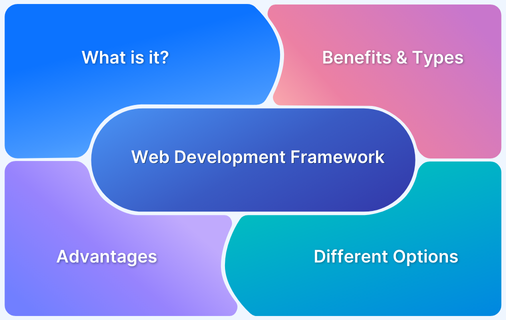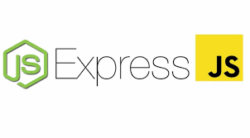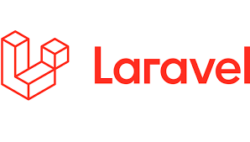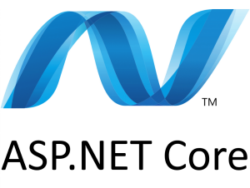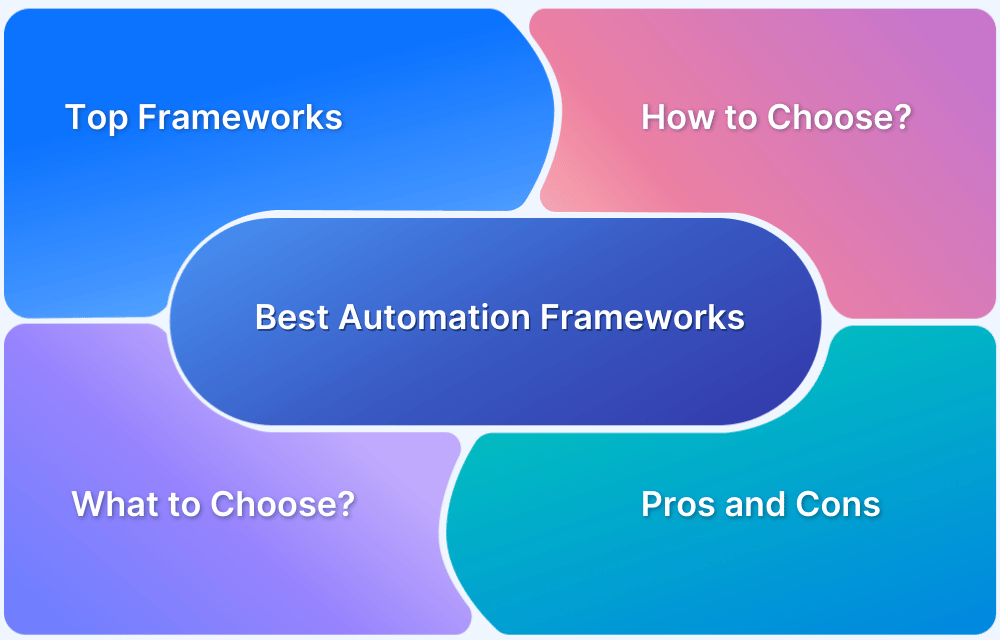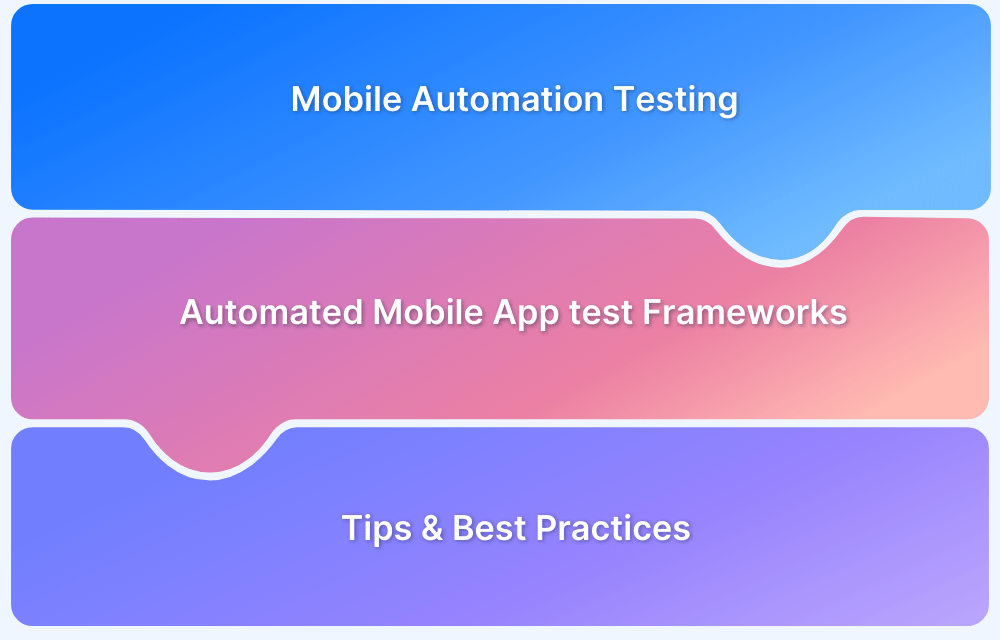Web frameworks offer pre-built solutions that speed up the development process while ensuring code quality and maintainability.
Overview
What is a Web Framework?
A web framework is a set of tools and libraries designed to simplify the process of building and maintaining web applications. These frameworks streamline development by providing reusable code and standardized structures that help developers save time and avoid common pitfalls.
Types of Web Frameworks
Front-end: Web frameworks that help build dynamic and responsive user interfaces (e.g., React, Angular, Vue).
Back-end: Web frameworks that handle server-side logic, databases, and API development (e.g., Node.js, Django).
This article explains web development frameworks, their benefits, types, limitations, and how to choose the right one.
What is a Web Development Framework?
A web framework often referred to as a web application framework is a pre-built set of libraries, software tools, and best practices that support the overall software development of web apps.
- It handle multiple routine tasks and proffer a structured way to organize code, making development more maintainable and efficient.
- It eases the web development procedure and, hence, makes it simpler to build a website and web apps.
- Using a web development framework can aid in guaranteeing that the final product possesses scalability, reliability, and maintainability, thanks to the consistent development approach it offers.
Benefits of using Web Development Frameworks
Using web development frameworks can bring multiple advantages to your development procedure, including:
- Streamlined development: Web development frameworks can be said to “bootstrap” the development procedure, offering templates to kick-start a project or code for features that are common to several projects.
- Speed and Efficiency: They allow software developers to build web applications more rapidly and with less code.
- Integrated Security: These types of frameworks come equipped with security traits (built-in) to safeguard against potential vulnerabilities.
- Community Support: Supports huge communities of software developers who offer resources and support.
- Enhanced performance & scalability: Frameworks help build a structure for web app development that is both optimized for scalability and performance—factors that also make these apps simpler to debug and maintain.
- Testing and Debugging: Provides several tools and features to make testing and debugging simpler.
What are the Different Types of Web Frameworks?
Web frameworks can be broadly categorized into two distinct types: Frontend and backend.
1. Frontend (Client-Side) Frameworks
Frontend frameworks mainly deal with the UI (user interface) and customer-side interactivity that further assists in front end testing.
- These frameworks operate within the customer’s browser and are responsible for managing user interactions, rendering content, and boosting the overall user experience.
- They are crucial to generating dynamic, responsive, and visually alluring web apps. Prime framework examples include Angular, Vue.js, React, and Ember.js.
Read More: Front-End Testing Strategy: A Detailed Guide
2. Backend (Server-Side) Frameworks
Backend frameworks are primarily designed to focus on the server-side logic of web apps.
- These frameworks manage server operations, communicate with databases, and process requests from the user side.
- They are responsible for the robust security, functionality, and data management of web apps. Notable backend frameworks examples include ASP.NET., Ruby on Rails, Express.js, Django, and Spring Boot.
Difference between Frontend Frameworks and Backend Frameworks
Web frameworks are categorized into frontend and backend types, each serving distinct roles in web development. Here is a comparison to highlight their differences:
| Aspect | Frontend Frameworks | Backend Frameworks |
|---|---|---|
| Purpose | Focused on building the user interface (UI) and user experience (UX). | Handles server-side logic, database interactions, and application architecture. |
| Key Functionality | Manages layout, styling, and interactivity on the client side. | Manages APIs, data processing, and server-side operations. |
| Execution | Runs in the browser (client-side). | Runs on the server (server-side). |
| Examples | React, Angular, Vue.js | Express.js, Django, Ruby on Rails |
| Technologies Used | HTML, CSS, JavaScript | Languages like Python, Java, Ruby, or Node.js |
| Primary Role | Enhances user interactions and visual appeal. | Manages business logic, data flow, and security. |
| Dependency | Relies on backend frameworks for data and APIs. | Works with frontend frameworks to deliver content to users. |
| Skillset Required | Proficiency in frontend technologies like JavaScript and CSS. | Knowledge of server-side programming and database management. |
Advantages and Disadvantages of Web Frameworks
Here are some of the notable advantages and disadvantages of web development frameworks:
| Advantages of Web Frameworks | Disadvantages of Web Frameworks |
|---|---|
| Rapid Development: Web Frameworks offer pre-built components, cutting down on the time needed for development. | Learning Curve: Developers require time to learn framework-centric practices and conventions. |
| Consistency: Frameworks enforce best practices, resulting in highly consistent and maintainable code. | Flexibility: Some frameworks might limit certain design choices or restrict customization. |
| Security: Web Frameworks every so often come with built-in security traits and protections. | Performance Overhead: Web Frameworks can introduce performance overhead because of their abstraction layers. |
| Community and Ecosystem: Web Frameworks have extensive libraries & active communities. | Compatibility and Updates: Keeping up with web framework updates and guaranteeing compatibility can be challenging. |
| Scalability: Various web frameworks support scalability through scalable and modular architectures. | Resource Consumption: Some web frameworks might consume more server resources than customized coded solutions. |
Top 10 Web Development Frameworks (Features, Benefits, Drawbacks)
Web development frameworks help developers build scalable, efficient, and maintainable applications with less effort and more flexibility.
The top ten web development frameworks are:
- Ruby on Rails (RoR): It is a full-stack web application framework written in Ruby, known for minimizing configuration by following common conventions.
- Django: Django is a high-level Python web framework that encourages rapid development and clean, pragmatic design, particularly suited for building secure and scalable web applications.
- Express.js: Express.js is a minimalist web framework for Node.js that offers a robust set of features for building web and mobile applications, commonly used with JavaScript-based stacks.
- Gatsby: Gatsby is a modern static site generator built on React. It is designed to create fast and SEO-friendly websites by pre-building pages and using GraphQL for data fetching.
- Angular: Angular is a TypeScript-based open-source web application framework developed by Google. It helps build dynamic, single-page web applications with a component-based architecture.
- Vue.js: Vue.js is a progressive JavaScript framework for building user interfaces and single-page applications. It is known for its simplicity and flexibility in integrating with other projects.
- Laravel: Laravel is a PHP framework designed for building robust web applications with elegant syntax, featuring an ORM, routing, authentication, and built-in tools for common tasks.
- Flask: Flask is a lightweight and flexible micro-framework for Python. It prioritizes simplicity and minimalism to help developers build small to medium-sized web applications quickly.
- Spring Boot: Spring Boot is a Java-based framework that simplifies the setup and development of production-ready applications. It is often used for microservices, with built-in support for embedded servers.
- ASP.NET Core: ASP.NET Core is a cross-platform, high-performance framework from Microsoft. It allows you to build modern, cloud-based web applications, APIs, and microservices using C#.
Here is a detailed description of each framework along with their features, benefits, and limitations.
1. Ruby on Rails (RoR)
Features:
- Convention over Configuration: Ruby on Rails enforces sensible defaults as well as conventions, decreasing the necessity for configuration.
- Model-View-Controller Architecture: It follows the MVC pattern for systemic code structure.
- Active Record: A dynamic ORM (Object-Relational Mapping) for database management.
- Gems: A huge library of gems (plugins) to extend functionality.
- Rapid Development: Popular for its speed in building web apps.
Benefits:
- Productivity: Faster development leads to rapid time-to-market.
- Community: Supportive and active community.
- Security: Built-in security features.
- Scalability: Supports scalable & modular design.
Drawbacks:
- Learning Curve: This could be steep for beginners.
- Performance: May face performance problems for higher-traffic apps.
2. Django
Features:
- Batteries Included: Django offers several built-in traits such as an authentication, admin panel, and an ORM.
- Model-View-Controller Architecture: Follows the MVC pattern.
- Django REST framework: Famous for building RESTful APIs.
- Security: Give emphasis to security best practices.
- Scalability: Supports scaling with comfort.
Benefits:
- Fast Development: Saves time with ready-made elements.
- Robust Security: Security traits such as CSRF protection.
- Versatility: Suitable for an extensive range of apps.
- Documentation: Excellent community and documentation support.
Drawbacks:
- Monolithic: Can be less flexible for microservices architecture.
- Complexity: Might feel overwhelming for small projects.
3. Express.js
Features:
- Minimalistic: A flexible and minimal Node.js web app framework.
- Middleware: Express.js supports middleware for custom response/ request management.
- Routing: Offers an easy yet robust routing system.
- Scalability: Perfect to build scalable, real-time apps.
Benefits:
- Speed: Higher performance for Node.js apps.
- Lightweight: Minimal overhead, appropriate for microservices.
- Community: Active and huge Node.js community.
Drawbacks:
- Lack of Features: Being minimalistic, it might require extra libraries for complicated apps.
- Learning Curve: Requires a robust understanding of Node.js and JavaScript.
4. Gatsby
Features:
- Static Site Generator: Results in fast-loading, optimized websites.
- React-Based: React for building user interfaces,
- GraphQL Integration: Leverages GraphQL for data querying.
- Progressive Web App (PWA) Support: Gatsby improves the user experience with offline access & other native app-like features.
- Rich Plugin Ecosystem: Helps add multiple functionalities, from image optimization to SEO optimization.
Benefits:
- Blazing Fast Performance: Improves user experience and SEO rankings.
- SEO-Friendly: Excels at SEO optimization.
- Great Developer Experience: Developers appreciate Gatsby’s use of advanced technologies such as React and GraphQL.
- Scalability: Making it appropriate for both large and small websites, content-rich platforms.
- Content Management: Integrates well with several CMS (content management systems).
Drawbacks:
- Static Limitation: This isn’t well-suited for apps requiring real-time data updates.
- Learning Curve: If you’re unfamiliar with GraphQL and React, there might be a learning curve linked with Gatsby.
- Build Times: Build procedure can become time-consuming, particularly on big projects.
- Plugin Compatibility: Requiring additional time and effort for troubleshooting.
5. Angular
Features:
- Full-Featured: Comprehensive web app framework with built-in tools.
- TypeScript: Strong typing for improved code quality.
- Two-Way Data Binding: Automatic synchronization of data and User Interface.
- Dependency Injection: Angular also promotes testability and modularity.
Benefits:
- Full Stack: Provides a complete solution for backend and frontend integration.
- Structured: Implements a well-structured codebase.
- Large Community: Active community with huge resources.
Drawbacks:
- Complexity: Can be overkill for easy projects.
- Learning Curve: Learning Angular and TypeScript concepts can take time.
Also Read: Angular vs AngularJS
6. Vue.js
Features:
- Simple Integration: Can be incrementally incorporated into projects.
- Reactivity: Automatic User Interface updates when data is modified.
- Component-Based: Similar to React, encouraging reusability.
- DevTools: Vue.js has its developer tools to debug.
Benefits:
- Flexibility: Suitable for both large and small projects.
- Learning Curve: Simple for beginners to pick up.
- Performance: Effective rendering and updates.
- Community: Supportive and growing community.
Drawbacks:
- Maturity: Slightly less mature than Angular or React.
- Less Prescriptive: A few developers prefer more structure in their web frameworks.
Learn More: Angular vs React vs Vue: Core Differences
7. Laravel
Features:
- Eloquent ORM: A smart, elegant, active-record execution.
- Blade Templating: Simple yet robust templating engine.
- Artisan Console: Command-line tool for several tasks.
- Middleware: Effortlessly define HTTP middleware.
Benefits:
- Developer-Friendly: Laravel aims to make development pleasurable.
- Modern PHP: Promotes advanced PHP development practices.
- Security: Built-in tools for security.
- Community: Robust Laravel community.
Drawbacks:
- Learning Curve: Necessitates familiarity with PHP.
- Resource Intensive: Can consume more server resources in contrast to minimalistic web frameworks.
8. Flask
Features:
- Microframework: Minimalistic and lightweight.
- Jinja2 Templates: A template engine to render HTML.
- Werkzeug: WSGI utility library to maintain HTTP requests.
- Extension Support: Effortlessly extendable with Flask extensions.
Benefits:
- Simplicity: Simple to understand and commence with.
- Flexibility: Perfect for small to medium-sized projects.
- Community: Active Flask community.
- Scalability: Can be used as a foundation for big apps.
Drawbacks:
- Limited Features: Lacks some built-in traits compared to huge web frameworks.
- May Require Extensions: Extending Flask’s functionality sometimes depends on third-party extensions.
9. Spring Boot
Features:
- Java-Based: Designed for Java-based apps.
- Spring Ecosystem: Uses the power of the Spring ecosystem.
- Embedded Servers: Supports embedded servers such as Tomcat.
- Microservices Support: Appropriate to create microservices architectures.
Benefits:
- Robustness: Popular for its reliability and robustness.
- Scalability: Appropriate to build scalable Java apps.
- Community: Active Spring community.
- Enterprise-Ready: Suitable for enterprise-level apps.
Drawbacks:
- Complexity: Spring Boot can be complicated for smaller projects.
- Java Knowledge: Requires strong know-how of Java.
10. ASP.NET Core
Features:
- Cross-Platform: ASP.NET works on Linux, Windows, and macOS.
- Model-View-Controller Framework: Supports the MVC architectural pattern.
- Entity Framework Core: An ORM for data access.
- Dependency Injection: Promotes testability and modularity.
Benefits:
- Cross-Platform: Enables building web apps for multiple platforms.
- Performance: High-performance apps.
- Integration: Seamless incorporation with Azure and other MS (Microsoft) technologies.
- Security: Robust security features.
Drawbacks:
- Learning Curve: This can be perplexing for beginners.
- Windows Focus: Historically linked with Windows development.
Each of these web frameworks has its weaknesses and strengths, making them ideal for distinct scenarios. Choosing the right framework depends on your unique project’s requirements and your development team’s proficiency.
How to Choose a Framework in Web Development?
Selecting the right framework depends on multiple factors:
- Project Requirements: Consider the precise requirements of your project, such as complexity, scalability, and performance.
- Licensing: Licensing is a crucial factor to consider while picking out a web development framework. It’s significant to pick a framework that has a license that lines up with the project’s objectives and goals.
- Good documentation: Good support and documentation are critical for any web development framework. They should have crisp and clear documentation that covers all the functionality and traits.
- Community and Support: A strong community can offer support, resources, and plugins.
- Cost and Budget: It’s important to select a web framework that aligns with the particular project’s budget and doesn’t have hidden charges.
- Learning Curve: Some frameworks might have a steep learning curve necessitating added training or specialized familiarity. It’s vital to pick a framework that has a manageable learning curve.
- Security: Prioritize frameworks with strong security traits. Security must be a top concern when choosing a web framework.
- Ecosystem: Evaluate the accessibility of libraries, plugins, tools, marketplace longevity, and third-party integrations. A thriving ecosystem is crucial for effective development.
Closing Notes
Imagine you have developed a stunning web app using a top-tier framework like React, Ruby on Rails, or Django. But the real test lies in confirming it functions flawlessly across multiple operating systems, browsers, and screen sizes.
Whether you are utilizing Angular, Vue.js, or any other web framework, BrowserStack lets you:
- Test your web apps on a diverse suite of devices and browsers, including the current versions.
- Automate tests to run constantly, catching regressions before they hit your users.
- Access over 3,500 real-time devices and browsers in the cloud, making it a great platform to spot and fix compatibility issues early in the software development cycle.
- Access Test Management and Test Observability for efficient debugging and insights.
